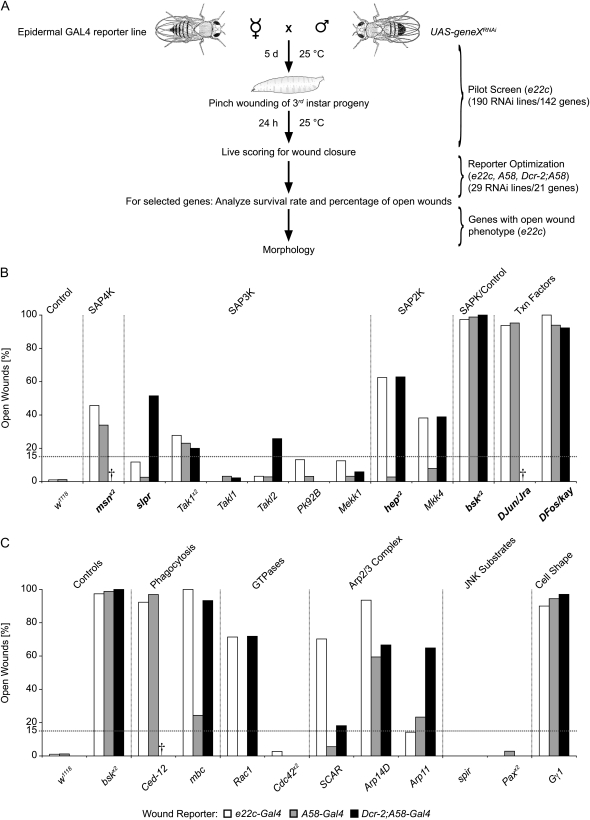Figure 3.—
Quantification of wound closure upon epidermal expression of UAS-RNAi transgenes. (A) Workflow of the UAS-RNAi–based screen for wound closure genes. (B and C) Percentage of open wounds upon expression of UAS-RNAi transgenes targeting indicated genes of the JNK pathway and other SAPK signaling components (B) and genes involved in actin cytoskeletal remodeling (C). Open bars, e22c reporter; shaded bars, A58 reporter; solid bars, Dcr-2;A58 reporter. w1118 crossed to the respective reporter was used as a negative control and bskRNAi as a positive control. Dashed line, arbitrary 15% cutoff for detailed morphological analysis. Daggers indicate insufficient L3 larvae for testing. Lines with two UAS-RNAi inserts targeting the same gene are denoted by x2. Genes in boldface type in B indicate members of the canonical JNK pathway. The numbers of scored larvae for each RNAi knockdown using A58 or Dcr-2;A58 in B and C were as follows: n(A58-Gal4) = 82 (w1118), 56 (msnx2), 39 (slpr), 39 (Tak1x2), 31 (Takl1), 35 (Takl2), 32 (Pk92B), 31 (Mekk1), 36 (hepx2), 38 (Mkk4), 84 (bskx2), 42 (DJun/Jra), 33 (DFos/kay), 33 (Ced-12), 41 (mbc), 31 (Rac1), 36 (Cdc42x2), 36 (SCAR), 37 (Arp14D), 30 (Arp11), 46 (spir), 35 (Paxx2), and 36 (Gγ1); and n(Dcr-2;A58-Gal4) = 72 (w1118), 33 (slpr), 35 (Tak1x2), 44 (Takl1), 31 (Takl2), 33 (Pk92B), 34 (Mekk1), 35 (hepx2), 36 (Mkk4), 69 (bskx2), 65 (DFos/kay), 30 (mbc), 35 (Rac1), 40 (Cdc42x2), 33 (SCAR), 33 (Arp14D), 37 (Arp11), 46 (spir), 34 (Paxx2), and 34 (Gγ1); see also Table S1 for n(e22c).

